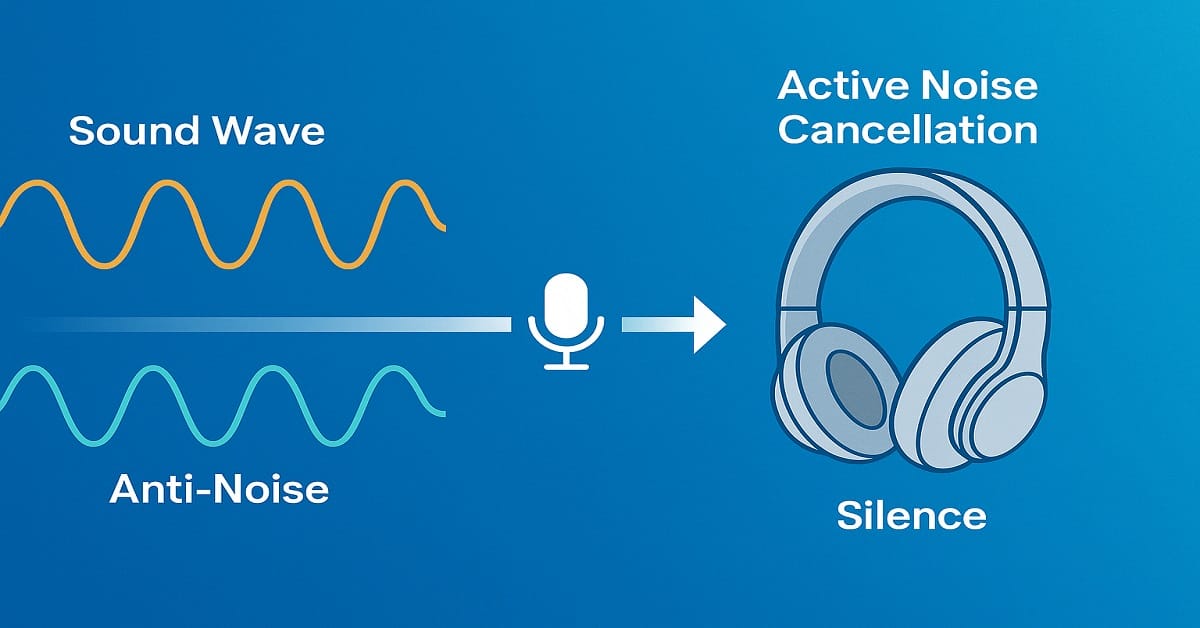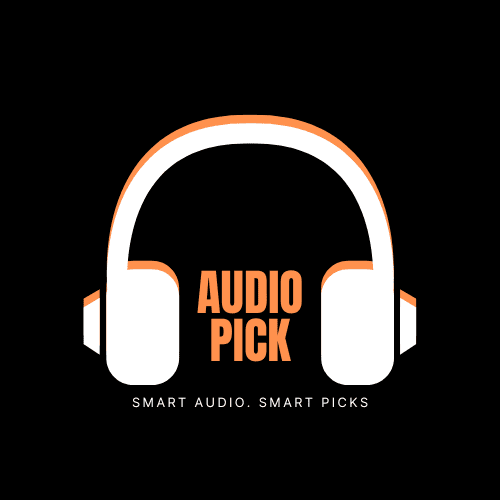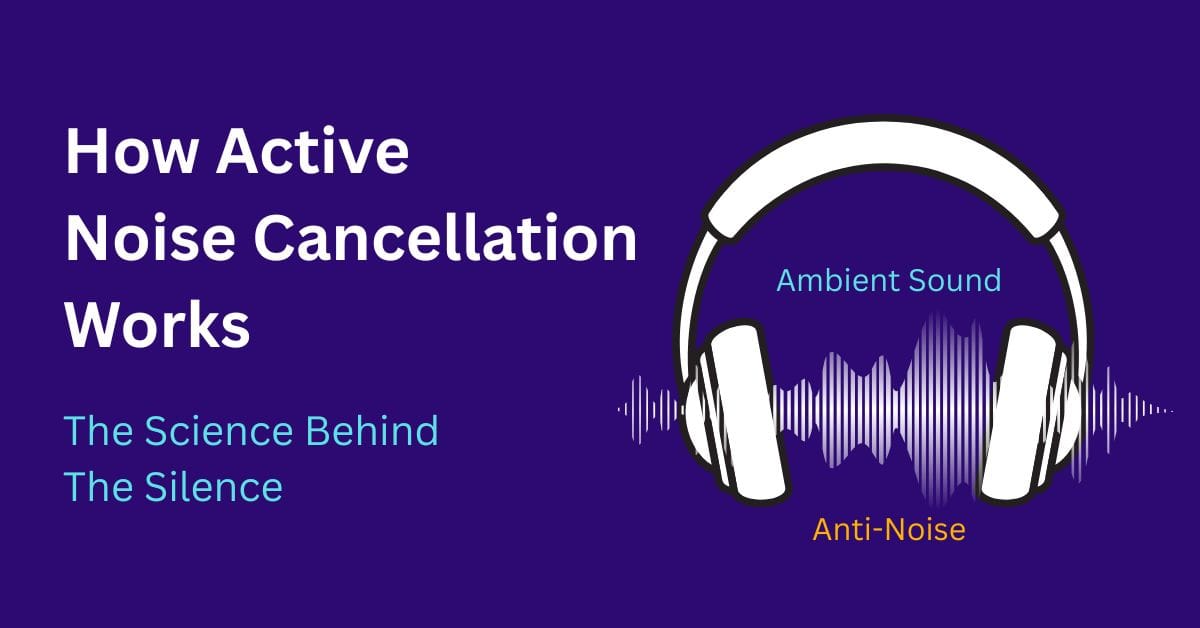You want quiet. Planes, trains, and offices are noisy and it gets tiring.
The problem is most explanations of active noise cancellation feel too technical.
This guide explains active noise cancellation in plain English: what it is, how it works step by step, the different types, where it helps, and where it does not. By the end you will know exactly when to trust ANC claims and how to pick the right device.
What is active noise cancellation?
Active noise cancellation is a system in headphones and earbuds that listens to outside noise and plays an opposite sound to reduce it. Think of noise as a wave. If you play the same wave upside down, the peaks and valleys meet and cancel. That is called destructive interference.
In simple terms: tiny microphones hear the rumble around you, a chip builds the opposite wave in real time, and your ears hear less of that rumble. This is different from passive isolation, which is just physical blocking with pads or ear tips.
How active noise cancellation works

- Microphones sense the environment
External and internal mics sample the air around your ears and the sound inside the cup or ear canal. - The DSP analyzes the noise
The digital signal processor measures frequency, loudness, and timing. It predicts what the unwanted sound will be a split second later. - Anti-noise is created
The chip generates a wave with the same shape as the noise but flipped 180 degrees. - Speakers mix anti-noise with your audio
Your music and the anti-noise play together. When anti-noise meets the incoming noise near your ear, they cancel or at least reduce each other. - Continuous correction
Noise changes every moment. The system keeps listening and adjusting so cancellation stays aligned.
Analogy: Picture two kids jumping on a trampoline. If they time their jumps in exact opposite directions, the trampoline stays flatter. ANC tries to time those “jumps” in sound.
Types of active noise cancellation
Feedforward ANC
- Mics outside the ear. They hear noise early.
- Good at handling consistent outside noise.
- Can misjudge sudden sounds because it predicts before the ear hears them.
Feedback ANC
- Mic sits inside near the driver.
- Listens to what you actually hear.
- Good at fixing errors but less effective with very high frequencies.
Hybrid ANC
- Uses both outside and inside mics.
- Wider cancellation range.
- Common in mid to high end models.
Adaptive ANC
- Adjusts strength based on environment and fit.
- Dials down in quiet rooms to save battery and reduce pressure feeling.
User-controlled levels
- Some earbuds let you choose Low, Medium, High.
- Useful to avoid over-cancellation and to save battery.
Advantages of active noise cancellation
- Lower listening volume which protects hearing and keeps music clear.
- Better focus on planes, buses, and open offices.
- Clearer details in podcasts and music because the background hum is removed.
- Comfort for long trips since engine rumble is exactly the kind of noise ANC cancels well.
- Works with passive isolation to cover more of the frequency range.
Limitations you should know
- Battery use. ANC drains power by running mics and a processor.
- Frequency limits. Best for low and steady noise like engines and AC. It struggles with quick, high-pitched sounds like claps or speech.
- Fit matters. A poor seal ruins cancellation, especially on earbuds.
- Artifacts. You might hear a faint hiss or feel pressure if tuning is aggressive or timing is off.
- Not a full replacement for isolation. Foam tips and thick pads are still better at very high frequencies.
Practical scenarios where ANC shines

- Flights. Jet engines produce steady low-frequency noise. ANC cuts this well, so movies and sleep are easier.
- Commuting. Trains and buses have a constant drone that ANC reduces without blasting volume.
- Open offices. HVAC and distant chatter fade, so you can focus.
- Home appliances. AC, refrigerator hum, washing machine cycles get less distracting.
- Studying and deep work. Keeps you in a bubble without needing loud music.
Comparisons that matter
ANC vs Passive Isolation
Passive isolation blocks sound physically and is strongest at high frequencies. ANC is strongest at low, steady frequencies. The best headphones combine both.
ANC vs ENC
ENC is for your microphone during calls. It cleans your voice for the other person. ANC is for your ears to make your world quieter.
Transparency mode vs ANC
Transparency uses the mics to pass outside sound into your ears on purpose. Good for walking outdoors or announcements at the airport. It is the opposite of ANC and many products let you switch quickly.
Don’t Miss These
- ENx Technology Means: Why It Matters in Modern Audio Devices
- Can I Sleep with a Neckband? Discover the Shocking Truth Today
- Bluetooth Codecs and Call Quality: How LC3, cVc, and aptX Voice Impact ENC Performance
- 7 Genuine Reasons Why Hybrid Noise Cancellation In Neckbands Is Worth It?
- ANC vs. ENC: 7 Jaw‑Dropping Truths to Choose the Ultimate Neckband
FAQs
1. Does active noise cancellation work without music?
Yes. Most devices let you enable ANC with no audio playing so you can sit in quiet.
2. Can active noise cancellation damage hearing?
ANC itself does not damage hearing. In fact it lets you listen at lower volume. Damage happens from loud playback, not from ANC.
3. Why does speech still leak through with ANC on?
Speech is complex and changes quickly at higher frequencies. ANC is weaker there. A good physical seal helps more for voices.
4. Why do I feel pressure with ANC?
Some profiles create a sensation like cabin pressure. Try a lower ANC level or switch to transparency in quiet rooms.
5. How much battery does it cost?
Every product is different, but expect 10 to 30 percent less playtime with ANC on.
6. Is hybrid ANC always better?
Usually, yes, because it covers more cases. But tuning quality and ear fit still decide the real result.
The Future of Active Noise Cancellation Technology
Active Noise Cancellation has come a long way from its early use in airplane headsets. What began as a specialized feature for pilots has now become a standard expectation in everyday consumer devices. But we’re still in the early stages of what ANC can become. The next few years will bring smarter, more adaptive, and energy-efficient forms of noise control that go far beyond simple “anti-noise.”
Smarter, AI-Powered Noise Detection
Traditional ANC relies on fixed algorithms. It listens, analyzes, and plays opposite waves—but it doesn’t understand context. Modern research is focusing on AI-powered ANC, where machine learning helps the system recognize what type of sound it’s hearing and respond more intelligently.
For example, your headphones might automatically lower ANC when they detect human voices (so you can talk) but ramp it up on a plane or subway. Sony’s “Adaptive Sound Control” and Bose’s “Smart Noise Cancellation” already experiment with this, learning your habits over time to personalize your experience.
Hybrid Sensors and Bone-Conduction Feedback
Future ANC systems won’t depend only on air microphones. Companies are testing multi-sensor ANC, combining air mics, bone-conduction sensors, and accelerometers that pick up how sound travels through your body. This helps devices adjust faster and cancel noise more precisely, especially in windy or variable conditions. It also opens the door to personalized ANC calibration, where the system learns how your specific ears perceive sound and tunes itself accordingly.
Lower Power, Higher Efficiency
Battery drain is one of the main complaints users have about ANC. Engineers are working on low-power DSP chips that can process anti-noise more efficiently without sacrificing performance. Some manufacturers are exploring hardware-level ANC—built directly into Bluetooth chipsets—to make cancellation faster and less energy-intensive. We’re also seeing experiments with hybrid analog-digital ANC, where analog circuits handle basic low-frequency cancellation and digital chips handle adaptive adjustments, saving significant battery life.
Integration with Spatial and Environmental Audio
ANC used to be about isolation, but now it’s blending with spatial audio and ambient awareness to create more natural experiences. Instead of simply muting the world, future systems will reshape it. Imagine sitting in a café and hearing only your friend’s voice clearly while background noise fades away automatically—that’s selective or “targeted” ANC, a concept currently being explored by audio labs at Apple, Qualcomm, and Sennheiser.
Beyond Headphones: Everyday Noise Control
Finally, expect ANC to move outside of headphones entirely. Car cabins, office spaces, and even home appliances are beginning to use active acoustic control to minimize environmental noise. Electric vehicles, for instance, already use ANC to mask tire and wind sounds. Soon, your car, laptop fan, or even your refrigerator could feature built-in noise cancellation.
The bottom line is this: ANC is shifting from a passive comfort feature to an intelligent, adaptive technology that shapes how we interact with sound itself. What started as a tool for silence may soon become a bridge to more immersive, personalized, and responsive audio experiences.
Conclusion and next steps
Active noise cancellation makes noisy places feel calmer by listening to the environment and playing anti-noise that cancels low, steady sound. It works best with a good fit and when paired with passive isolation. It will not erase sudden or high-pitched sounds, and it uses more battery, but for travel and work it is a real upgrade.
Actionable tips
- Test ANC in a noisy spot before buying.
- Choose hybrid or adaptive ANC when possible.
- Get the right ear tips for a tight seal.
- Use low or medium ANC in quiet rooms to reduce pressure and save battery.
- Keep firmware updated. Tuning often improves over time.
Enjoyed the Read? Spread the Silence!
If this article helped you understand how Active Noise Cancellation truly works, take a moment to share it with your friends, family, or anyone curious about audio technology. The more people learn about how ANC brings peace to our noisy world, the better choices they can make when buying their next pair of headphones or earbuds. Sharing this post not only helps others discover useful information but also supports us in creating more easy-to-understand, research-based guides for everyday listeners.

About the Author
Hari Prasad is the editor of AudioPick.in and a lifelong audio enthusiast. He writes detailed, honest reviews and guides to help everyday users pick the right gear without tech jargon. His personal interest in Bluetooth audio, neckbands, and codecs comes from testing dozens of devices over the past few years.

